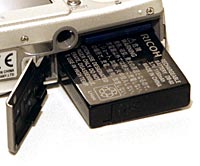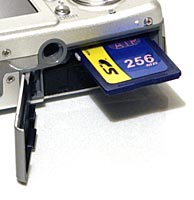Ricoh Caplio R3 Review
Review Date: December 13th 2005
|
Ease of Use
The Ricoh Caplio R3 is a very compact digital camera that easily fits in the palm of your hand, and it is also very light at around 135grams, principally because of its all-plastic construction. This is one camera that you truly won't notice carrying in a trouser/shirt pocket or a handbag. It has an under-stated appearance that is fairly attractive, but which isn't going to really impress anyone either. A sticker on front of my review sample proudly proclaims that the Ricoh Caplio R3 has a 28-200mm zoom range, a truly amazing feat of engineering in such a small camera. When the lens is fully extended, the camera measures over 7cm in depth, but thankfully it retracts fully back into the camera when it is turned off. One curious design element which I don't understand the reason for is a gradual 10 degree bend in the camera body on the right hand side (looking from the back). I'm not really sure why Ricoh have done this, other than to prevent the R3 from being too box-like and boring in shape. Consequently the corner of the small flash unit protrudes very slightly from the front of the camera.
Everything on my sample unit was well-built, except for the battery/memory card cover, which I would probably describe as broken and send back if it was my own personal camera. The hinge didn't seem to be fitted properly, and consequently there was too much horizontal movement when the cover was open, causing it to fit poorly. Something to watch out for if you're considering this camera. The only other questionable design aspect are the AV-Out and USB ports on the side of the camera, which are completely unprotected by a flap or cover. Otherwise the build quality of the Ricoh Caplio R3 was perfectly acceptable, with the metal band that runs around the entire edge of the camera literally holding things together.
The Ricoh Caplio R3 is a point and shoot camera with no advanced exposure controls, so it's not particularly complex in terms of its design. There are 11 external controls in total, leaving plenty of room for the large 2.5 inch LCD screen that dominates the back of the camera. The R3 follows the design of previous Ricoh cameras by having a vertical row of buttons on the rear, to the right of the LCD, along with the zoom lever and the navigation pad. One of these vertical buttons is the Adj. button, a particularly nice feature that allows you to quickly adjust 2 different settings that are commonly used. Press it once and you can alter exposure compensation; press it again and you can change the White Balance setting. Even better, the Adj. menu is customisable - you can add two more settings to it and also choose what those settings are, allowing you to control exactly what you want quick access to. I added ISO speed and metering mode. The other thing that I liked was the Power button, positioned on the top of the camera. Unlike many digicams, the Ricoh Caplio R3 has a dedicated button that lets you turn the camera on and off, regardless of which setting the camera is currently set to. It's not the most radical feature in the world but a nice addition nevertheless.
| Power / Shutter Release / Vibration Reduction Buttons | Sound/Movie/Camera / Play / Adjust Menu / Delete/Timer / Display Buttons |
 |
 |
There is one innovative feature on the Ricoh Caplio R3 that aims to make life easier for you. This camera has an anti-shake system, dubbed Vibration Correction- turn it on and the Ricoh Caplio R3 automatically compensates for camera shake, which is a slight blurring of the image that typically occurs at slow shutter speeds. There are two different modes, Mode 1 is on all the time including image composition, and Mode 2 is only on when you press the shutter button. You don't notice that the camera is actually doing anything different when anti-shake is turned on, just that you can use slower shutter speeds than normal and still take sharp photos. However, what Ricoh gives you in the form of an effective anti-shake system, it takes away by providing a limited usable ISO range of 64-200, as the faster ISO speeds all exhibit high levels of noise (see the Image Quality page). This essentially means that you really need to leave the anti-shake system turned on all the time to compensate for the slow shutter speeds, which kind of negates any real advantages that the anti-shake system offers. Thankfully leaving the anti-shake system on didn't negatively affect the battery-life, with the camera managing over 250 shots before the battery needed to be recharged.
If you have never used a digital camera before, or you're upgrading from a more basic model, reading the comprehensive and easy-to-follow manual before you start is a must. Thankfully Ricoh have chosen to supply it in printed format, rather than as a PDF on a CD, so you can also carry it with you. The large 2.5 inch LCD screen is the only way of framing your shots, so if you have to have an optical viewfinder, look elsewhere now. Unfortunately the LCD screen on the R3 has a completely inadequate 110,000 pixels, resulting in a rather grainy image. The various icons used to represent the camera settings are clear and legible, although I was annoyed by the LCD brightness message along the bottom of the screen, which is displayed whenever you press the Display button (did Ricoh copy this from Panasonic?).
The main menu system on the Ricoh Caplio R3 is straight-forward to use and is accessed by pressing the Menu button in the middle of the navigation pad. There are two main menus, Shooting Settings and Setup. Quite a lot of the camera's main options, such as image size, sharpness, metering mode and continuous mode, are accessed here, so the Shooting Settings menu has 16 options spread over 4 screens. Due to the large LCD screen and restricting the number of on-screen choices to 5, the various options and icons are very clear and legible.
| Battery Compartment | Memory Card Slot |
 |
 |
Ricoh are well known for delivering responsive cameras, and the Caplio R3 is no different to its predecessors. The start-up time from turning the Ricoh Caplio R3 on to being ready to take a photo is very quick at around 0.5 second, and it only takes just over 1 second to zoom from the widest focal length to the longest, impressive given the focal range. Focusing is very quick in good light and the camera happily achieves focus most of the time indoors or in low-light situations, helped by the focus-assist lamp, although the process is a little strange. Instead of sending out a red beam, as most cameras do, the Ricoh fires the flash twice in an attempt to provide enough light for the camera to achieve focus, which works more often than not. Note that the camera does struggle to lock onto the subject sometimes at the tele-photo end of the lens. The visibility and refresh rate of the 2.5 inch LCD screen are perfectly acceptable, although as noted above the image is very grainy. It takes about 0.5 second to store a JPEG image, allowing you to keep shooting as they are being recorded onto the memory card - there is no LCD blackout between each image. In the fastest Continuous mode the camera takes 3 frames per second for up to 6 images at the highest JPEG image quality, which is above average for this class of camera. Note that the camera does lock-up for around 2 seconds after the sequence is finished while it stores the images. The most annoying aspect of the camera's speed is the flash recycle time - you have to wait for a few seconds before you can take another flash photo, which is very annoying. All in all the Ricoh Caplio R3 is very quick in terms of operational speed.
Once you have captured a photo, the Ricoh Caplio R3 has an average range of options when it comes to playing, reviewing and managing your images. You can instantly scroll through the images that you have taken, view thumbnails, zoom in and out up to 8x magnification, view slideshows with audio, set the print order, delete, protect and resize an image. The Display button toggles detailed settings information about each picture on and off, such as the ISO rating and aperture / shutter speed, and there is a small histogram available during both shooting and playback. When taking a photo, pressing the Display button toggles between the detailed information, the histogram and gridlines to aid composition.
In summary the Ricoh Caplio R3 is a staightforward, unassuming, very responsive point and shoot compact camera that offers something different to the rest of what is a crowded martketplace.
|
